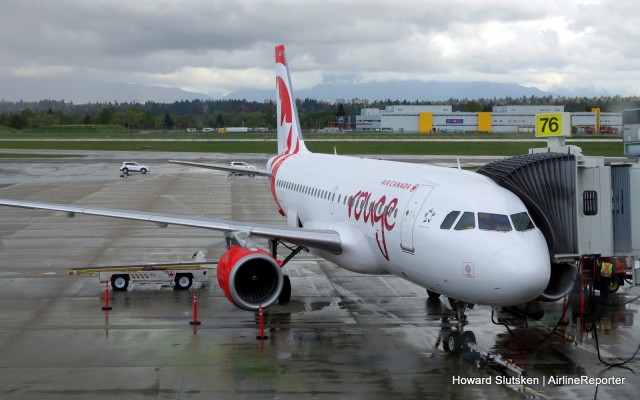
Air Canada rouge’s inaugural YVR-LAS Airbus A319 flight at the gate on a rainy Vancouver morning
You may have read the recent commentary and analysis by AirlineReporter’s Bernie Leighton, “You Get What You Pay For Rant: Why Economy Class Is What It Is.” I certainly did. It seemed fitting, then, that just a couple of days later, I was invited to Vancouver International Airport (YVR) for Air Canada rouge‘s first Western Canada flight.
Air Canada rouge is an “airline within an airline”, and is part of the Air Canada Leisure Group along with inclusive-tour operator, Air Canada Vacations. The airline is positioned as Air Canada’s “Leisure” carrier, intended to get passengers to their vacation destinations. Air Canada rouge launched last July 1st with flights from Toronto (YYZ) and Montreal (YUL) to Europe, the Caribbean, Mexico, and the U.S. In addition to specific vacation travel, Air Canada is hoping to make its unprofitable routes financially viable by a transfer to Air Canada rouge, which has lower operating costs. Bernie talked all about that, and CASMs and RASMs, in his rant.
By the end of 2014, Air Canada will have transferred 47 routes to rouge. Another seven routes new to the AC network will be operated exclusively by rouge. The just-announced Western Canada routes include YVR to Las Vegas, Los Angeles, San Francisco, Phoenix, and seasonal service to Anchorage. From Calgary, flights will go to Las Vegas and Los Angeles.
The Air Canada rouge fleet is made up of Airbus A319s and Boeing 767-300ERs, transferred from Air Canada’s mainline fleet. As of the end of April, there were 15 A319s and four 767s flying for the leisure carrier. Ultimately, rouge may have up to 30 A319s and 20 767s, with the 767s coming into the fleet as Air Canada receives its new 787 Dreamliners.
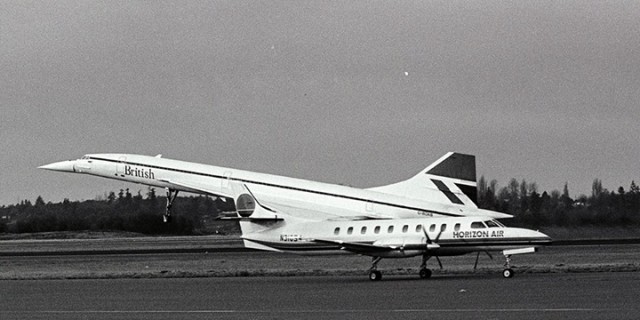
A British Airways Concorde visits SEA – Photo: Seattle-Tacoma International Airport
Today, Concorde is no stranger to the Seattle area — there is a British Airways Concorde sitting just south of Seattle at the Museum of Fight. But back in 1984, a Concorde had not yet visited Seattle. That all changed near the end of the year.
According to HistoryLink.org, on November 15, 1984, Concorde made its first trip to Seattle and it was for a special event.
It landed at Boeing Field (BFI) first to prepare for a special fundraising flight for the Museum of Flight. The plane arrived with a load of recently bottled Beaujolais nouveau wine and Seattle restaurant owner Mick McHugh along with a few guests. The wine was specially brought to Seattle as quickly as possible to be enjoyed, and what better way than via a Concorde?!
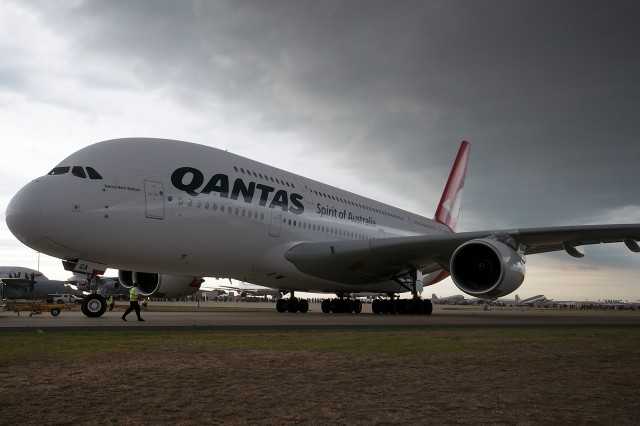
VH-OQA, a Qantas A380-841 on the ramp at Avalon Airport, Victoria five years ago – Photo: Bernie Leighton | AirlineReporter
On the 3rd of December, 2013, Emirates took the crown with having the longest Airbus A380 route in the world — from Dubai to Los Angeles. The route is only 418 miles longer than the longest Qantas A380 route from the Melbourne to Los Angeles.
Qantas is fighting back with their recent announcement that they are going to take back the longest A380 flight crown, maintain the status of the longest commercial flight, and one-up Emirates.
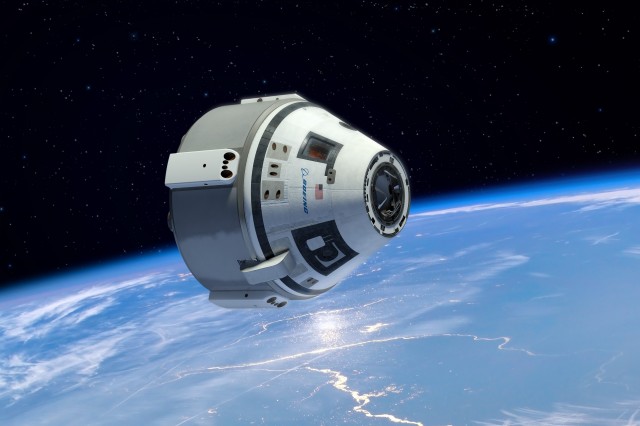
The Boeing CST-100 – Image: Boeing
I recently had the opportunity to head to Las Vegas (insert Viva Las Vegas song here) to learn about some pretty interesting advancements in commercial space travel; specifically, with the Crew Space Transportation (CST-100) from Boeing. The company sees an increased demand from governments, corporations, and private citizens to get to space, and they are placing their bet that the CST-100 can provide a solution.
The CST-100 is being designed as part of NASA’s Commercial Crew Integrated Capability initiative, which is trying to find a private solution to transport crew and supplies into space. The winner could be considered the replacement for the Space Shuttle.
Boeing is one of three companies (the other two are Space Exploration Technologies, aka SpaceX, and Sierra Nevada Corporation) competing for NASA’s business. When the decision is made, NASA could choose just one winning design, or could choose to go with two. Obviously, Boeing is hoping to be in the winner’s circle.
The goal with the CST-100 is to not to only be functional, but to also provide an impressive interior, and Boeing has some interesting ideas.
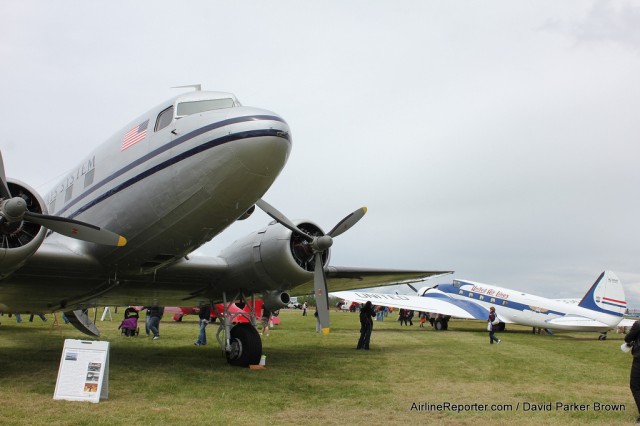
The Historic Flight Foundation’s DC-3 and the Museum of Flight’s Boeing 247 in United livery
Seattle area folks – are you ready for another Paine Field Aviation Day?! Of course you are!
Last year was another amazing year. We were able to see so many planes, like the Boeing 247 and DC-3, mixed with a Boeing 787, AN-124 (happened to be there), Boeing 747-8I and many more.
Information from PaineField.com:
On Saturday, May 17, 2014, the Washington Pilots Association (WPA), Paine Field Airport, Flying Heritage Collection, and Historic Flight Foundation will host the 19th Annual Paine Field Aviation Day from 9am – 3pm.
![This is the only Hamilton H-47 [first flown in 1928] in the world left flying. It was caught taking off from Paine Field with a Dreamlifter and 787 Dreamliner in the background.](https://www.airlinereporter.com/wp-content/uploads/2013/08/PaineField1-640x426.jpg)
This is the only Hamilton H-47 [first flown in 1928] in the world left flying. It was caught taking off from Paine Field with a Dreamlifter and 787 Dreamliner in the background.
Paine Field Aviation Day FAQs:
Our previous coverage:





![This is the only Hamilton H-47 [first flown in 1928] in the world left flying. It was caught taking off from Paine Field with a Dreamlifter and 787 Dreamliner in the background.](https://www.airlinereporter.com/wp-content/uploads/2013/08/PaineField1-640x426.jpg)